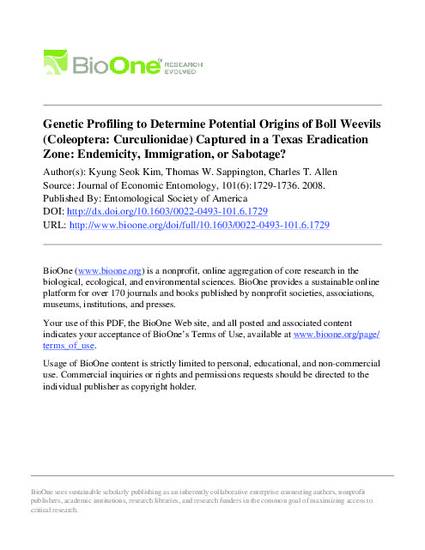
Thirty-seven boll weevils, Anthonomus grandis grandis Boheman (Coleoptera: Curculionidae), were captured in pheromone traps near Lubbock, TX, in the Southern High Plains/Caprock eradication zone during August–October 2006. No boll weevils had been captured in this zone or neighboring zones to the north earlier in the year, and only very low numbers had been captured in neighboring zones to the south and east. Therefore, the captures near Lubbock were unexpected. Five of the weevils captured the last week of August were preserved and genotyped at 10 microsatellite loci for comparison with a database of genotypes for 22 boll weevil populations sampled from eight U.S. states and four locations in Mexico. The Lubbock population itself is an unlikely source, suggesting that the captured weevils probably did not originate from a low-level endemic population. Populations from eastern states, Mexico, and Big Spring, TX, can be confidently excluded as potential source regions. Although the Weslaco and Kingsville, TX, areas cannot be statistically excluded, they are unlikely sources. The most likely sources are nearby areas in New Mexico, TX, or southwest Oklahoma, or from areas of eastern Texas represented by Waxahachie and El Campo populations. Together, genetic and circumstantial evidence suggest either that the trapped boll weevils are the offspring of a lone mated female that immigrated from eastern Texas earlier in the summer or that weevils originally captured near Waxahachie but now long-dead were planted in the traps by a disgruntled employee of the eradication program.
Available at: http://works.bepress.com/thomas_sappington/53/

This article is from Journal of Economic Entomology 101 (2008): 1729, doi:10.1603/0022-0493-101.6.1729